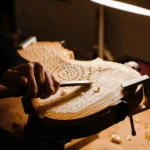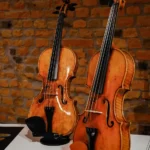The Amorim Method: An Interview with Luiz Amorim
Back to BlogLuiz Amorim established his own stringed instrument workshop in 2001 and has been perfecting and developing his method of making ever since. With work now referenced all over the world, Luiz Amorim gives us his insight into what makes a great luthier.
What is the Amorim Method?
“The Amorim Method is our approach for reproducing the most authentic copies of original instruments. I have developed this over many years through the observation and study of classical makers’ construction processes, as well as scrutinizing the aging and natural wear of the instruments, in order to produce a copy which has the soul of the original”.
“My idea when antiquing is to imagine the natural process, which led the instrument to stay that way. I capture the essence and character of the instrument which I am copying.”
How do you do it?
“For me, the development of the Amorim Method came through careful observation of how natural wear and tear occurs. As a result of understanding this, we recreate the antiquing appearance with artificial but also natural methods to create the most authentic finish. The main goal of the process is to capture the essence and character of the instrument which I am copying.
“It is important not only to study and observe the instrument but also the maker and the life they had. With greater knowledge of the maker, we can understand what they were looking for at the time they were creating the instrument. Every artist leaves their impression in some way on the work. It reflects what they were experiencing at that moment. Whether they lead an unpredictable, stable, or creative life, the characteristics of their life will be seen in the instruments they made.
“Stradivari had a very stable job and a generally comfortable life, but within this technical stability, he had, we can still see his creative side. In contrast, Guarneri’s unstable life meant he developed a habit of reinventing and applying different techniques constantly. This resulted in instruments which are as differing and chaotic as the different stages of his life”.
What makes the Amorim Method different?
Fine arts in the lutherie
“When studying fine arts, we focus a lot on the practice of observing the image. Through the observation of the image, you can reflect what you see on paper, whether it be through the medium of pencil, coal, or ink. On a violin, when a reproduction is made, there will always be this process of observation in much the same way as observing a portrait, a drawing, a photo, or a still life.
“This observation process exists in Lutherie, which in itself is an art form or form of expression. Means of expression exist in all fields. You can also express yourself by doing your work on a computer, writing a book, or by dancing; everything can be linked to the creative process.
“We see this process when making an instrument. We, too, are able to leave our own expression on the instrument. The process of copying an instrument is mainly an accurate observation, but this leads to deeper work to the point where you can recognize the instrument being copied as a portrait of the maker. Reproduction can be done in an expressive way, but it does not have to be labored and forced; you can also have a lot of freedom and, in the process of the work, have an expressive approach”.
Through the process of copying an instrument, how is it possible to put your own expression into the pre-established confines of the original instrument?
“It is difficult to express in words. When I studied fine arts, I passed from table to table, looking at the work of my colleagues, and it was incredible to see how each one had a different perspective. The same happens when you are going to copy an instrument, even with the same proportions, same volute, same forms; it is impossible to recreate an identical soul of one instrument in another. Each one will have its moment of expression.
“For example, all the instruments that I have made do not have exactly the same appearance, even if it’s the same copy. There will always be the character of the instrument, its essence, but together with that in some way, a portrayal of what I was feeling at that time. When musicians play, I believe that they are also imprinting what they are feeling at the moment too. We are human beings; we are not machines, we express ourselves”.
Do you think it is your artistic approach that differentiates you? Why are you valued for your work by both musicians and experts in the field?
“I think that the expression in your work comes with practice. At the beginning of my career, I saw myself as a maker. I used to make very mechanical copies; I see now that they were mechanical because I was still starting my work process. My career and I didn’t have so much maturity and knowledge, which I now use to express myself. This expression comes with time, and with my work, I try to be as authentic as possible.
“I think that authenticity is seen by the customer, and they somehow know I do what I do honestly, creatively, and freely. When I am working, I am not stressed about the final result. I try to focus on the present moment, the details, the colour, the wear, and in the end, a work of art appears.
“When I talk about expressing myself, it doesn’t mean that I’ll only express myself when I am working on my personal models – this is a different design, not just expression. You can have the same design and the same shape but still, express yourself there in that model in a different way to the original. Like Guarneri, who had a standard mold, yet each of his instruments are different in detail and those small details were his expression at that time. He let himself be inspired, let himself be carried away; he was not fixated on that initial drawing at all”.
What is the importance of being in Cremona to make copies? How does a location enable you to make the best quality pieces?
“Being in Cremona is synonymous with tradition and quality. Cremona has always been a reference for quality instruments. Having the possibility to see other makers, to see great instruments on a daily basis, makes it possible to train the eyes and improve the technical and even artistic aspects. What really makes a difference when it comes to antiquing is to look at as many instruments as possible and to have a clear vision, to observe the essence of the old instrument. The possibility of being in Cremona and living in this environment, breathing the air of Guarneri, Stradivari, and Amati, is an inspiration. To be a part of a new generation of great Cremonese luthiers is simply a pleasure”.
Find out more about Luiz Amorim and his instrument-making career by visiting his page.









